PREPARATORY TRAINING: GENDER AND WASH MONITORING TOOL

(GWMT)
A Sample Trainer’s Guide (Version 1, July 2014)


(GWMT)
A Sample Trainer’s Guide (Version 1, July 2014)
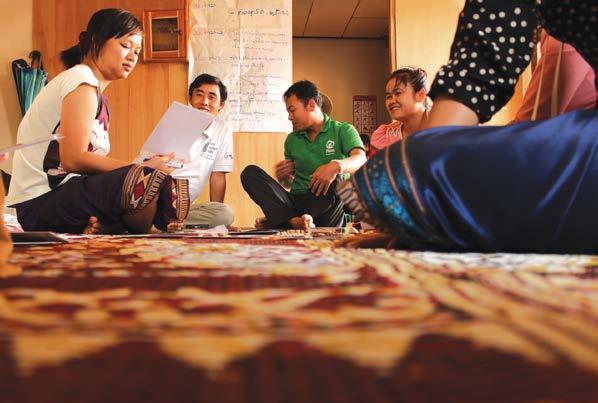
For further information, or to provide case studies and feedback, please contact Plan International Australia WASH team at WASH@plan.org.au
All resources can be downloaded from: www.plan.org.au/learn/gender-and-WASH-Tool
This booklet was compiled by:
Lee Leong – WASH Program Manager
Krissy Nicholson – WASH Program Manager
Deborah Elkington – Gender Advisor
Elizabeth Hogan – Monitoring, Evaluation and Learning Advisor
Plan International Australia
Acknowledgements: Plan Vietnam and Consultants Matthew Bond and Claire Rowland were contracted for the first version of the tool.
Note: Some activities and guidelines around gender have been adapted from Plan’s Gender and Child Rights Training Manual -‘Planting Equality –Getting it right for girls and boys’. For example ‘Addressing Challenging Gender Questions’ on pg 16, and some activities within the session plan.
Congratulations! By reading this guide, you are already on your way to be able to train others on the Gender and WASH Monitoring Tool (GWMT). Your participation will contribute to successful implementation of this important tool designed to improve WASH programs and gender equality, by regularly monitoring changes in gender relations. As a trainer, you and your training team will have the role of ensuring your program has competent people to put the GWMT into practice in communities.
It is important to note that this guide is an example only, of how preparatory training on the GWMT could look. It was developed based on a pilot conducted by Plan’s Vietnam WASH team and project partners. While it is a comprehensive, step-bystep guide that will help you on your journey to implement the GWMT, it is essential that it is adapted to suit the context you are working in, and the current level of understanding of your WASH Team about gender equality and analysis. Please feel free to be creative and to use alternative activities that may be a better fit for your situation. Regardless of how you adapt it, preparatory training is essential prior to using the tool. We recommend that participants (your WASH Team) should at a minimum, have already undertaken training on gender.
This guide goes hand in hand with the GWMT. We suggest all trainers read the GWMT first and have it available to refer to when reading this training guide.
Both guides and accompanying tools and activities can be downloaded from: www.plan.org.au/learn/gender-and-WASH-Tool
Here you will find
• GWMT Guide
• Photo and clock cards
• Record Sheet templates for all steps
• Preparatory Training Guide (this one)
• Useful training activities and hand outs
• Demonstration video for trainers
• Training activities and hand outs.
Please note a full review of both the training and the GWMT will take place in 2015/2016. Plan will post updated versions when they are available.
IMPORTANT NOTE: This is not Gender Training. Participants should already have basic knowledge of key gender analysis concepts and their application to programs. The training is aimed at practitioners who currently monitor WASH progress within communities, therefore a good understanding about general monitoring is also assumed.
This training will guide participants to build upon their current knowledge and understanding of gender, and monitoring, to apply successfully in their WASH programs.
Who is it for:
The GWMT and training is designed for anyone who is implementing a WASH program. In particular WASH practitioners, program managers, government workers, Monitoring, Evaluation and Learning (MEL) specialists, and gender advisors.
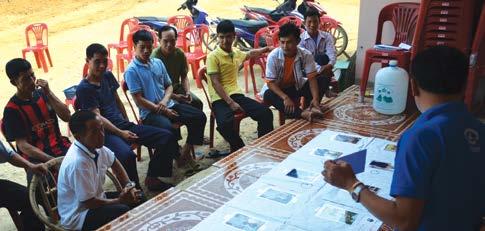
Why is it important:
WASH is an important entry point to contribute to gender equality. WASH projects affect gender relations in a community whether it is intentional or not. The effectiveness and sustainability of WASH programs is enhanced when there is an explicit focus on gender equality. While many of us already know this, integrating gender strategies into WASH programs and monitoring their progress towards change can be a challenge. The GWMT is designed to assist this process.
The GWMT enables local project staff and Government partners to explore and monitor gender relations with women and men in implementation of WASH related initiatives. It comprises a series of participatory rural appraisal (PRA) activities (the GWMT booklet) as well as preparatory training (this booklet). The GWMT seeks to address the following dual aims:
• To raise awareness about gender roles and relationships in household and community WASH activities
• To promote (aspirations for) gender equality by providing opportunities for women and men in WASH program communities to discuss gender relations and to set their own agenda for change.
• To support WASH implementing staff to strengthen their understanding of gender analysis
• To develop practical skills for gender monitoring
• To collect sex-disaggregated information
• Use information to strengthen WASH projects to promote and support gender equality.
This training is a key component required to implement the tool. It provides an opportunity to ‘trial’ the tool within communities, within a supervised training environment. The experiential nature of the training also provides an opportunity for participants to strengthen their capacity and understanding of gender analysis as they have the chance to ‘practice’ within real contexts. See Diagram 1.
Remember that the GWMT is a monitoring tool. It does not replace the need for integration of a range of strategies to address gender equality in WASH projects. As a trainer you need to make it clear that gender strategies are integrated at all stages of the WASH program. GWMT indicators should be embedded within the project’s monitoring, evaluation and learning framework and the use of the tool AND other gender strategies are adequately resourced.
Diagram 1: Outline of the GWMT process
Gender and WASH monitoring tool guidebook
Regular monitoring process within a project’s monitoring, evaluation and learning framework
Preparatory Training: GWMT –A sample trainers guide
For new GWMT users and refresher trainings as needed
Facilitators’ Meeting (After Community PRA Activities)
8. Analysis of community’s progress towards gender equality
Community PRA Steps
1. Introduction
2. Women’s and men’s work in household and community WASH
3. Women’s and men’s role in household WASH decision making
4. Facilitated sex and age disaggregated discussion
5. Desired changes for women and men
Project Implementation Team
9. Documentation and improving practice
6. Sharing results
Preparatory/Refresher GWMT Training
Preparation + Adaptations
7. Closing
Preparations and adaptations to the GWMT as needed to suit project context and learning.
For project implementation team (the GWMT facilitators and note takers being trained)
GWMT training team undertake preparations and start adaptation of the GWMT to suit project context
*
* Please note preparation and adaptation of GWMT can take several months with intensive support.
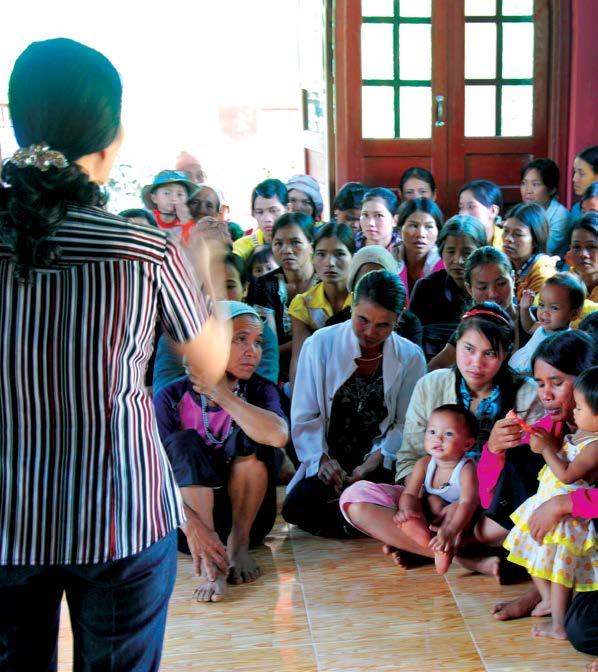
Preparation is key to the success of the GWMT Preparatory Training. This section outlines information on how many and the experience required from trainers, through to the key components of the trainers role, tips for preparation and information on the training participants. Don’t underestimate the time it takes to prepare for the training. It is likely to take at least a few months to ensure you have everything in place. In Vietnam it took up to six months of preparation, adaptation and support. Happy preparing and good luck!
Training team composition:
As this training is a 5 day intensive with a lot of coordination and field visits, it is important to ensure there is more than one trainer. In Vietnam, the team was made up of 5 Trainers including: a Lead Trainer who was the Gender Specialist; 2 WASH Program Managers; Regional WASH Advisor; and a Gender Advisor. Logistics was organised by the Vietnam WASH Team.
Keeping in mind the size and context of your training group, choose your training team carefully and clarify roles. At minimum it is suggested that a Gender Specialist and WASH Program Manager who meet the minimum experience required (outlined below) are within your training team.
The training team should be made up of trainers who have the following experience:
Experience in facilitating participatory training
Strong understanding of key gender concepts and analysis, and experience in monitoring gender
Familiarity with participatory rural appraisal (PRA) methods
Understanding of WASH concepts
Knowledge of the WASH program
Good organisational skills
Flexibility and adaptability
Speak the local language and understand cultural norms.
If a lead trainer does not have all of the above experience, it is important that they ensure their support trainers do.
This section outlines general tips on the role of trainers throughout the training. Please revise with your training team.
Create a safe learning space:
Introduce and greet people warmly, smile, build engagement and trust
Tell people there are no wrong questions and all opinions are valid
Develop agreements enable participants to fully contribute and encourage respect for others opinions, culture, gender
Ensure room is set up to facilitate small groups so that people feel more confident to talk openly (i.e. Not lecture style)
Promote and practice listening between participants (active listening).
Ensure clarity on purpose of GWMT:
Ensure participants are clear that monitoring gender is not separate from their general programming. It needs to become an integrated part of their monitoring framework throughout all stages of their WASH program. It will become ‘business as usual’
Ensure key concepts are communicated well and understood by participants
Ensure that you and your participants are clear on the purpose of every activity.
Documenting key learnings:
Trainers will be responsible for taking notes to capture and record key outputs and learnings throughout the training. These can then be integrated into changes required for future trials and trainings. You will see reminders throughout the session plan, however learnings should be documented throughout the whole process.
Facilitate learning:
Draw upon their experience in Gender and Monitoring to emphasise key learnings, as well as drawing experience from participants
Always ask for participant observations: ‘Why is it so?’ and ‘So What’, ‘What else?’ to stimulate conversation and analysis
Always make the linkages between activities clear
Summarise key learning points at the end of each component – draw on conclusions, debates and dialogue that participants have bought up during workshop
Recognise different levels of understanding and pace of learning for participants. Appreciate positive efforts and acknowledge barriers, then focus on what support is required
Encourage everyone to contribute and recognise the experience in the room
Don’t do all the talking: remember your job is to ask questions and get participants to do the talking.
Keep the energy high:
Look for signs of tiredness or boredom. When people get tired, change the activity, do a quick energiser or take a short break
Even if you are tired, ensure you are friendly and up beat. People will be more engaged if they are having fun while they are learning. Remember to smile!
Give clear instructions for activities:
Explain slowly and clearly, step by step. Demonstrate processes and steps where needed
Ask for questions or clarification about the activity
Once people are in groups, check in with them to ensure the task is understood
Ensure people are clear about their roles
Ensure participants have processed, analysed and understood the learning behind the activity
In the debrief, ask people how they felt, what they learnt, how they think this activity would play out in real life, and summarise key learnings.
Identify participants roles for field trials during training:
Strong facilitation and gender analysis is important for the success of the GWMT in the field. Trainers will need to be watching participants in the training room setting, and watch for those with strong skills in these areas. These participants should be encouraged to volunteer to facilitate the tool on the field trips. Stronger facilitators can be paired with those who are not as strong. And those who are not confident in facilitating can choose to be observers and note takers.
Manage time:
While it is important to be flexible with your training and let conversations flow freely, keep to time as much as possible. Ask permission from participants if agreed time lines will be broken.
Remember the evaluation:
A lot of trainers skip this part however it is important not only for improving the content and methodology of a training, but also to gain feedback on how our own facilitation skills can be improved.
Discussing gender can stimulate a range of opinions. This can be a valuable opportunity to clarify perceptions about gender equality and any implications for monitoring gender relations in WASH. What ever question comes up, (remember all questions are invited) it is important as a trainer to encourage people to learn from each other and to extend their understanding and experience. It is important not to judge the person who has asked the question or made a comment but rather to help consider that perspective in the context of gender equality concepts and principles. Here is an example of how you may deal with challenging questions.
Let’s imagine that a participant states: “It’s a woman’s job to collect water and clean the toilet. It’s just a part of our culture”. The facilitator can respond with the following four steps:
Step 1: Ask for clarification: “I appreciate you sharing your opinion with us. Can you tell us why you feel that way?”
Step 2: Seek an alternative opinion: “Thank you. So at least one person feels that way; what do the rest of you think? Does anyone here have a different opinion?”
Step 3: If an alternative opinion is not offered, provide one “A lot of people would disagree with that statement. As we know by understanding the difference between sex and gender, gender roles and responsibilities are a social construct, and can change over time.”
Step 4: Offer facts that support a different point of view. “Can anyone give an example of other gender roles that have changed over time? For example, what is one thing that your grandfather/grandmother could not do, because it was not socially acceptable at the time, but that you are able to do due to changing gender roles.”
Key points: How we see gender AND culture can and does change and there are lots of examples to show this. For example:
A few generations ago, my grandmother could not go to university, but now as a woman I can.
What other examples can you think of?
What other training tips can you add:
There are so many training resources out there with books on ‘how to be a good trainer’. If you would like more confidence as a trainer, please explore ‘Training of Trainer’, Facilitation and presentation skills trainings and take note of trainers that you admire.
Good Luck!
Below is a guide of preparation and resources that need to be organised before the training takes place.
Securing organisational commitment over the life of the WASH program
Identify an ongoing commitment from trainer(s) e.g. to run refresher trainings
Establish how the GWMT (and indicators) will be integrated into the WASH program’s MEL framework
Allocate required resources for ongoing use of the tool e.g. budget, human resources
Commitment from the organisation’s Senior Management Team
Consider who else needs to be engaged in the process to ensure success.
Discussing with project partners
Discussions with project partners (including government counterpart and local CSOs) who form part of the implementation team are required to gain commitment before the training and roll out of the tool.
Understanding and practicing the use of the tool:
Ensure your training team feels confident about the tool to enable clear facilitation. Decide who will lead each session and each trainer’s role
Read this Trainers Guide, the Gender and WASH Monitoring Tool and accompanying resources in detail. Make sure you understand the process and concepts before the training
Download and understand key documents from GWMT website to ensure you have the right training resources ready: www.plan.org.au/learn/gender-and-WASH-Tool
Practice and feel confident to be able to demonstrate key steps in the tool for the role plays to take place. See video to watch someone else demonstrate, and practice with your training team before the training: www.plan.org.au/learn/gender-and-WASH-Tool
Adapt according to your local context
Tailor the training to ensure local needs are met. Consider both participants of the training and the communities you will be working in. The GWMT guidebook should be translated into the local language prior to the training
Adapt training activities and field work to the learning needs and number of participants (the current training design is for 30 participants).
Developing context-specific photo cards
The photos used in this version of the tool were appropriate for use in the central highlands of Vietnam. New photos will need to be taken to represent the communities you work in download here: www.plan.org.au/learn/gender-and-WASH-Tool
Field trials will need to be organised ahead of time. The nature of the field work will vary depending on the adaption of your training approach for the local context. In Vietnam, the following were considerations:
Pre-determining the number of villages that will be visited. In Vietnam it was 2 villages for first day trial, and 3 villages for second day trial
Choosing communities where there is an existing strong relationship or familiarity with the project staff and government counterparts
Communicating to the communities selected for the training that it is a trial run for facilitators
Ensuring equal numbers of men and women of different age sub-groups are chosen and prepared prior to the training visit for each selected community
Take appropriate measures to ensure the selection of community participants include those who may otherwise be marginalised. For example, people living with disabilities or particular ethnic or minority groups
Ensuring appropriate government permission is granted as required
Ensuring a time that is suitable for community visits and planning for contingency (for example if there is an unexpected funeral in a village, what will you do instead?)
Preparing logistics for field trials (e.g. transport, materials, place for meeting and smaller break-out spaces, etc).
Please download all resources from here:
www.plan.org.au/learn/gender-and-WASH-Tool
Preparing the workshop room
Prepare workshop materials including:
Flip charts
Flip chart stands (if available)
Powerpoint and projector
Marker pens, blue tac, masking tape, post-it notes and/or coloured cardboard
Print enough copies of handouts including:
GWMT guidebook (including supporting materials e.g. laminated clock cards, photo cards, record sheets).
Write up key flip charts in advance.
for Trainers
Prepare group work activities:
Gender Concepts: Print and cut out cards
Watch and practice demonstrations for role plays Room set up:
Small group tables scatter around the room with 6 chairs each
Projector and computer
GWMT Overview Presentation is translated, loaded onto the computer and ready to present
Logistics:
Ensure venue and equipment, catering, accommodation, transport, materials, accessibility for people with disabilities, and other logistics as required.
The training is designed for 30 participants. This will ensure maximum benefit both in the training room, and for allocating roles for the field trials. If this is different in your context, you will need to adapt training activities, field visits and group work.
Participants will be project teams who are responsible for implementing and monitoring WASH programs. This is usually project staff, government counterparts and local partner staff from civil society organisations. Plan Vietnam found that inviting senior provincial and district staff members from government who are responsible for WASH is helpful in gaining ongoing commitment and for them to understand the importance of monitoring gender in WASH programs.
Where possible it is important to have a gender balance in participants.
Ideally participants should:
• Be experienced community facilitators who understand participatory approaches
• Already be implementing and monitoring WASH programs
• Have an understanding of Gender Concepts and analysis in relation to WASH
** Remember, this is not a gender training. If participants don’t already have knowledge in this area, a pre-workshop Gender training is advised.
To implement the GWMT in the community, clear roles and responsibilities need to be allocated and prepared for. The roles include ‘Lead Facilitator’, ‘Co-Facilitators’ and ‘Note takers’.
The training room will be a safe space where participants will have the opportunity to practice these roles, through watching demonstrations and participating in role plays.
Those who are more confident in facilitation and gender analysis should be encouraged to volunteer to play lead and co-facilitator roles within the field trial.
Below is an explanation on the roles required by participants to implement the tool in a community setting (Steps 1-7).
During the piloting of the GWMT there were six facilitators and six note takers, each working with a different sub-group. Preferably female facilitators work with the women sub-groups, and male facilitators work with the men sub-groups. While this is the ideal situation, there are often not enough people to play each role. Where there are limited numbers, we suggest some facilitators also take the role of a note taker.
The Lead Facilitator’s role is to lead the GWMT community meeting including open and introduce key staff at each community meeting, and facilitate the plenary sessions. The Lead Facilitator also leads one sub-group during Steps 2 and 3 of the tool. As a form of gender role modelling within the second pilot, Plan encouraged rotating the Lead Facilitator to ensure female staff got the opportunity to play this role.
The Co-Facilitators work closely with the Lead Facilitator and Note Takers. They are responsible to lead one sub-group each (e.g. older men). Where possible, male facilitators should be paired with the male sub groups, whilst females should work with the female sub groups. Thus, together with the Lead Facilitator, it is ideal to have a facilitation team of 3 females and 3 males. In plenary sessions, Co-Facilitators should ensure their group’s view is represented, and if necessary gently encourage participants to speak up. As with the Lead Facilitator, Co-Facilitators will ensure that participation is maximised within in their sub-groups and that everyone has an opportunity to input their opinion. Co-Facilitators may also need to play the role of Note Takers if there is not enough staff.
Note Takers (ideally 6 people) work with the Co-Facilitators and actively observe and take detailed notes of the discussion and outcomes of each session on the record sheets. Preferably, there will be one Note Taker to one Co-Facilitator to ensure sub group’s contribution is recorded.

The purpose of the GWMT preparatory training is to ensure participants can confidently and competently utilise the GWMT with communities to monitor WASH programs for changes in gender relations.
By the end of the training, participants will:
Know:
• Key gender concepts
• Why it is important to monitor gender in WASH programs
• What is the gender and WASH monitoring tool (training and PRA tool) and how to use it in communities
• The different roles of Facilitators and Note Takers
• Recognise facilitation capacities and strengthen through practice and peer support
• What is required to adapt and implement the GWMT within your project’s context
• Where the GWMT sits within the WASH program’s regular monitoring framework.
Feel:
• Confident in monitoring gender relations within WASH projects
• Confident to use the GWMT in communities.
Do:
• Practice facilitation skills using the tool within the group (training room)
• Observe and learn from others facilitating the tool in communities
• Be a part of a team to run the GWMT in a community
• Collate, analyse and utilise the results
• Develop an action plan for adaption and use of the GWMT within your project’s context.
The following is a sample session plan for a five-day GWMT preparatory training. It is adapted from GWMT preparatory trainings that have been undertaken within the Plan Vietnam WASH program.
It is one way that the training could be delivered. We encourage you to develop training that is suitable for the context you work in and the participants in your group.
Gender activities within this sample session plan are examples that can be used to refresh basic gender concepts. These should be adapted depending on the current level of gender theory knowledge and understanding of participants.
Many of the gender activities are adapted from Plan International’s ‘Planting Equality: Getting it Right for Girls and Boys’ training manual, however you may like to draw upon guidance from your own organisations gender resources and adapt accordingly.
This suggested GWMT preparatory training is broken into the following 4 components:
1. Introduction Pre-Trial: Participants will be reminded about key gender and WASH concepts, introduced to the GWMT and start practicing using the GWMT within the training room
2. Practice and Observation Trial: A chance to see and experience the GWMT in action in a community
3. Full Trial: All participants experience facilitating the process in a community
Table 1.1 provides an overview the how the 4 components could be scheduled over a 5-day training period. This may vary according to your context and needs. Sample Session Plan for GWMT
4. Post-Trial workshop: Collate and analyse the results; debrief - including assessing the experience, tool and processes; and developing next steps
Table 1.1: Sample Five-day GWMT preparatory training overview
Post-Trial Workshop (training room)
Review the trial. Analyse the results, refine the tool and facilitation processes, next steps
Debrief
Day 4
Full Trial (community)
Trial in 3 communities with everyone playing a role
Day 3
Practice and Observation Trial (community)
Day 2
Trial in 2 communities with most confident facilitators/note takers leading and others observing
Introduction and practice of steps 5-9
Day 1
Day 5 Introduction Pre-Trial (training room)
Time
Gender concepts –WASH specific
AM
Review and process the learning from trial
Preparation for trial in communities
Overview of Tool. Introduction and practice of steps 14
PM
Participants and Trainers will be broken into 3 groups –1 group for each community. At least one trainer to be allocated to each group. Each group will consist of 10 participants who wil play different roles. Gender balance preferable.
Roles:
Participants and Trainers will be broken into 2 groups –1 group for each community. Trainers to be divided equally to support and observe participants. Each Group will consist of 15 participants who will play different roles. Gender balance preferable.
30 Participants in Training Room to learn and practice in safe learning environment
Break down of Roles
1 Lead Facilitator who will also lead subgroup
5 Co-Facilitators
4 note takers (paired with facilitator)
Due to numbers, trainer can play role of note taker and a facilitator will need to take notes as well as facilitate.
Roles:
1 Lead Facilitator who will also lead subgroup
5 Co-Facilitators
6 note takers (to be paired with a facilitator)
3 observers that can provide feedback
30 Participants in Training Room to debrief and analyse experiences and results from trial Sample
REMEMBER: This sample session plan is designed for 30 participants. All activities and field work will need to be reviewed and adapted if participant numbers in your context are different.
The session plan has been developed so that trainers can easily follow steps to facilitate a successful training. The plan is divided into 4 areas: Time, Purpose, Process and Materials.
Time: is approximate time taken for the activity. This may may vary depending on the size of the group and the capacity of participants to grasp concepts and information. When you plan your training, please allocate sessions to real time eg. time of day you begin and end, and your expected break times. These can then be communicated in an agenda to your participants and will help with planning.
Purpose: is the expected outcome of the activity. It is good practice to tell participants the purpose before you begin a new activity, and re-iterate the purpose at the end to consolidate learning.
Process: is a step by step guide of what to do to achieve the purpose of the activity. In some cases, we have provided a range of expected answers to questions asked, to help trainers ensure key aspects are covered.
Materials: is a list of resources required for the activity to take place.
Training overview (annex 1), name tags, marker pens
Process
Register participants and give out name tags if required. Give out training overview (Annex 1)
Purpose
Registration
Welcome: Welcome everyone. This week we will be learning to apply the Gender WASH Monitoring Tool. Provide a short introduction of the Gender WASH Monitoring Tool with the following points :
• As a simple explanation: GWMT is a series of participatory rural appraisal (PRA) activities used in a community meeting setting to collect monitoring data to assess changes in gender relations over time.
• The purpose of the tool includes:
Participants feel welcome and have an overview understanding of what they will be learning.
• Raising awareness about gender roles and relations in the community
• Develop practical skills in gender monitoring for WASH staff and partners
• GWMT is not designed or intended to be a standalone tool for gender monitoring in WASH. It should be one of many gender strategies and monitoring activities in your WASH program.
Time
Materials 15 mins
45 mins
(GWMT)
Introduce Agenda: This 5 day training will be broken into 4 components:
1. Introduction: Here you will be reminded about knowledge on gender and WASH and introduced to the GWMT itself and start practicing using the GWMT within the training room.
Participants understand the break down of the 5 day training.
2. Practice and Observation: A chance to see and experience the GWMT in action in a community
3. Full Trial: Everyone experiences facilitating the process in a community
4. Post-trial workshop: Collect and analyse the results, and debriefing including assessing the experience, tool and processes and developing next steps
Pre-written Flip chart with Objectives to introduce and refer back to throughout the training.
Introduce Objectives:
Write Objectives on a flip chart to refer to throughout the training. By the end of the training, you will:
Key gender concepts Why it is important to monitor gender in WASH programs
Know:
Participants understand the objectives of the training and have an opportunity to express their expectations.
What is the gender and WASH monitoring tool (training and PRA tool) and how to use it in communities
The different roles for Facilitators and Note Takers
Recognise facilitation capacities and strengthen through practice and peer support
What is required to adapt and implement the GWMT within your project’s context
Where the GWMT sits within the WASH program’s regular monitoring framework
Confident in monitoring gender relations within WASH projects
Feel:
Confident to use the Gender and WASH Monitoring Tool in communities
Practice facilitation skills using the tool within the group (training room)
Observe and learn from others facilitating the tool in communities
Be a part of a team to run the GWMT in a community
Collate, analyse and use the results
Do:
Develop an action plan for adaption and use of the GWMT within your project’s context
Ask the group if there are other aspects they are expecting to cover in the training. Respond by adding expectations to the list or clarifying if this is outside the scope of the training.
Flip charts
Flip charts Flip chart stands (if available) Marker pens Masking tape
Introductions and Expectations: Facilitate a short introduction exercise and warm up activity
Group Agreements: Ask the group to form ‘agreements’ to work together over the next 5 days. Write up on flip chart and get agreement from group (such as mobile phones off, being punctual, respecting different levels of knowledge and experience, listening with respect, etc.).
Participants feel energised and agree on how they will work together in the next 5 days.
GENDER RELAY: This session is an excerpt from Plan International’s ‘Planting Equality: Getting it Right for Girls and Boys’
Objective: To understand the importance and relationship between Gender and WASH. Set-up (set up before training begins)
• This is an activity where participants work in two teams and try to record as many correct sex or gender characteristics as possible. The team with the greatest number of correct characteristics wins
• Place two flipchart stands next to each other to allow for enough space for each team to form a line in front
• Mark a starting line on the floor at least 2 metres from the flipchart stands
• Divide the flipchart paper into two columns, then draw a line across the middle to create two rows
• At the top of the left column write ‘Sex’ and at the top of the right column write ‘Gender’. Label the top row ‘Women’ and the bottom row ‘Men’. Repeat on the second flipchart paper
• This should be a fast moving and fun game. Put pressure on teams by reminding them of how much time they have left and counting down the last 15 seconds
• Use the results of the relay as a way of clarifying key concepts of sex and gender.
Introduction
• Ask participants to form equal length lines in front of the flipchart stands. Explain that this is a relay and the marker is the baton
• There are two gender terms on each flipchart, and spaces to put characteristics for men or women under each term
• For example ‘head of household’ could be written under men as a gender characteristic or ‘give birth’ under women as a sex characteristic
• The first participant will run up to the flipchart and write down one characteristic (for either sex or gender, women or men), then run back to the line and pass their marker to the next person
• The point is to get the most correct entries in the time available
• Make sure participants understand the game, and then begin the relay! End the Relay
• End the relay after about 5 minutes (depending on the number of participants and how fast they are moving).
Review in Plenary
• Review each characteristic in plenary, awarding a point for each correct answer. When reviewing each team’s results, ask for explanations or rationales. The aim of the activity at this point is not so much to see who wins but to clarify concepts for participants
• Ask and add the following key characteristics if they haven’t come up:
• Women collect water (gender)
• Women need menstrual hygiene facilities (sex)
• Men make decisions about acquiring a toilet for their household (gender).
Trainer notes:
• ‘Strong’ is often written as a sex characteristic for men but it is more accurately a gender characteristic! Ask what is meant by strong: is it how many kilos someone can lift at one time, how many kilometres someone can walk with a heavy weight on their head, or how many hours they can work in the fields? Point out that what we think of as ‘strong’ is socially determined, and in fact by many definitions (such as stamina) women are as strong as or stronger than men
• ‘Tall’ or ‘taller’ is often written as a sex characteristic for men. This one is difficult –in most situations adult men from one group are taller than adult women from the same group. However, women from the Netherlands, for example, are likely to be much taller than men from Indonesia. Also, people’s heights have increased over generations due to better nutrition. So is being tall a sex characteristic? Or is it more of a result of ethnicity, nutrition, etc?
Morning tea break
mins
Process
Changes over timePersonal experience:
In pairs: Identify one thing that you can do as a woman/man that your grandmother/grandfather could not do.
Purpose
Time
Materials 1 hr 10 mins
Discuss:
• What is the change that you have seen?
• What are the benefits, or challenges of this change for men, women, families, communities?
Report back : ask for examples from the groups
Discuss /process: the observations of the group in terms of the changes that they think have occurred and whether there are differences in the experience of men and women? Alternatively, explore what (if anything) has stayed the same for men and for women?
To ensure a shared understanding of gender as a social construct. To explore change in gender roles (Division of Labour) over time, drawing on personal experience.
Debrief for both Activities –gender relay and changes over time: Ask the group: What are the key learnings from the last two activities?
• Key Message: Gender is a social construct and WASH roles and responsibilities (division of labour) can change over time. It is possible and this is what we have to remember when working in communities.
Materials
Gender concepts and definitions cards: download from link provided.
Process
Gender Concepts Exercise:
Matching concepts with definitions (30 mins) Refer to Annex 2, and download activity from:
www.plan.org.au/learn/gender-and-WASH-Tool
Purpose
Time
Preparation : Before training, download, print cards and be clear on instructions.
To understand key gender concepts and how they relate to WASH.
30 mins
Flip chart paper and markers
• Stick the Concept Titles to the wall with all the definitions mixed up on the floor
• Instruct the participants to look at all the concepts and definitions, and as a group decide which concept matches the definition
• Ask them to stick the correct definition to match the concept on the wall
• Go through each concept reading the definitions out loud. Ask participants : Have they all been correctly matched? Do any need to be swapped?
• Facilitate a discussion around the key concepts and why they are important to understand in WASH.
ASK: Why is gender equality important to WASH? (15 mins)
Facilitate a discussion on why gender equality is important to WASH and write on flip chart.
Notes: Some reasons include:
Trainers
• To ensure that program effectiveness is maximised by promoting gender equality
To understand why gender equality is important in WASH programs.
15 mins
• To ensure that those most burdened / affected by WASH related issues are able to participate appropriately in WASH initiatives including decision making processes
• To ensure that WASH initiatives are reaching the most marginalized
• To ensure WASH programs do not have unintended negative outcomes for women and men (e.g. reinforcing negative gender stereotypes, adding to women’s workload).
Why is gender equality important to WASH? (cont.)
• To enable you to make decisions about adapting your WASH program and ensuring that it is making progress in achieving desired changes in gender relations
• To contribute to organisational commitments to gender equality
GWMT presentation downloaded from link provided Projector/ screen
• To ensure that WASH programs are promoting the rights of women and men, girls and boys
GWMT guidebooks (that have been translated into the local language)
• Need to harness all the resources of the community by engaging both women and men.
Presentation: Introducing the GWMT: See Annex 3 for overview and access full presentation through this link: www.plan.org.au/learn/gender-and-WASH-Tool
To provide an introduction and overview of the GWMT.
NOTE: Presentation slides and voice over are currently in English. Please translate if required
Presentation will provide information on:
• Roles and responsibilities
• Background and purpose
• Learning to date.
• GWMT steps
Handout the GWMT guidebooks:
• Ask the participants to open the guide and briefly highlight the key components. Participants will get to know this guide well this week so no need to go into detail now. They should read the guide in detail for homework tonight!
Participants to familiarise themselves with the key components of the GWMT guidebook.
30 mins
Purpose
Time
Materials 30 mins
Gender Group activity (30 mins) In small groups (10 mins):
Monitoring
1. What’s your understanding/definition of monitoring
2. What is the purpose of monitoring (based on your practice)?
3. Why is it important to monitor gender in WASH?
Plenary report back: (15mins) Ask groups to share their discussions and write key points on a flip chart.
To refresh on the meaning of monitoring and its purpose and application in relation to gender equality.
Check key points (5 minutes): Reinforce points that have already been brought up and cover points that have been missed.
Trainers notes: What is monitoring?
One definition could be: Monitoring involves the methodical and regular collection and analysis of information to provide management and other stakeholders with early indications of progress and achievement of project or program objectives. Systematic monitoring assists timely decision-making and accountability and provides the basis for further evaluation and learning.
Examples of how monitoring could be described:
• Emphasis on both process and outcomes
• A mix of quantitative and qualitative methods
• Collecting information that is relevant
• Collecting disaggregated data on gender; disability; ethnicity, age etc.
• Participatory approaches
• Experimentation and innovation
• A focus on change, what has happened and why
• Creating space for reflection and learning.
Flip chart paper Marker pens
GWMT Guide
Flip charts paper Photo cards Clock cards
Trainers notes (cont):
What’s the purpose?
• Improve the effectiveness of our development practice
• Strengthen both accountability and learning
• Genuine participation of primary stakeholders
• Learning and continuous improvement.
To refresh on the meaning of monitoring and its purpose and application in relation to gender equality.
30 mins
Why is it important to monitor gender changes in WASH?
• To promote greater inclusion and equality
• To ensure WASH programs do not have negative outcomes for women and men (e.g. reinforcing negative gender stereotypes, adding to women’s workload)
• To provide feedback if your WASH program is having the desired changes for women and men.
Demonstration and Role Play Step 1, 2 and 3 of the GWMT
Copies of record sheets for note takers (All can be downloaded and printed from link provided)
Trainer Tip: To prepare for this session:
• Watch demonstration video and practice BEFORE you present to participants. Video link and materials to print are here: www.plan.org.au/learn/gender-and-WASH-Tool
To understand and apply Steps 1, 2 and 3 of the GWMT.
• Ensure all materials such as guide books, copies of notetaking pages, clock and photo cards are pre-printed. Explain that we will now have an opportunity to put the tool into practice. In the community the whole tool will take a couple of hours to implement and will flow continuously.
For the purposes of learning and practice, the trainer will be demonstrating the steps and the participants will then put them into practice using a series of role plays. This will help you to understand and apply each step of the tool in the training room before we take it into the communities.
1 hr
GWMT
Copies of record sheets for note takers (All can be downloaded and printed from link provided)
Process
Demonstration and Role Play Step 1, 2 and 3 of the GWMT (cont.)
Today we will be practicing steps 1 –4. Step 1: Introduction Step 2: Women’s and men’s work in household and community WASH Step 3: Women’s and men’s work in household WASH decision making Step 4: Facilitated age and sex disaggregated discussion
Purpose
Time
Materials 1 hr
To understand and apply Steps 1, 2 and 3 of the GWMT.
Demonstration: Trainer to demonstrate steps 1, 2 and 3 with the whole group. Explaining each element of the step and allowing time for questions of clarification. Step 4 will come later.
Role Play:
Purpose: For participants to understand and apply steps 1-3 of the GWMT. Divide participants into 4 groups. If uneven numbers of men and women participants, some men will have to play the role of women and visa versa.
• the middle aged women
• the middle aged men
• the younger women
• the younger men.
GWMT Guide
Flip charts paper Photo cards Clock cards
Process
Demonstration and Role Play Step 1, 2 and 3 of the GWMT (cont.) Explain the roles of Facilitators (Lead and Co-Facilitators) and Note Takers (see page 10 of GWMT guide book).
Copies of record sheets for note takers (All can be downloaded and printed from link provided)
Purpose
• Ask for one volunteer to be a facilitator, and one to be a note taker for each group.
To understand and apply Steps 1, 2 and 3 of the GWMT.
Time
Materials 1 hr
• Allocate one of the Facilitators to be the ‘Lead Facilitator’ who will lead Step 1 –introduction
• The rest of the group will be the community who must follow the instructions and ask appropriate questions of the Facilitators as if simulating a real situation. (NOTE: If there are not enough participants to allocate a facilitator and note taker then the facilitator can take notes as well)
• Ask everyone to refer to the steps within the GWMT guidebook. Guide the Facilitators to follow the steps outlined in the book, paying particular attention to the key questions outlined in the steps
• Provide the note takers with photocopies of the record keeping pages for each step
• Ensure the group are clear on the task before beginning the role plays
• Role play to begin ensuring everyone stays in role. Trainers to supervise groups being available for questions and to move people along to ensure time management.
• Once Steps 1-3 complete, Trainer to allow a few observations and questions before moving straight into Step 4 role play. Tell participants there will be lots of space for more questions after Step 4.
Step 4 Role Play: Facilitated sex and age disaggregated discussion (sex subgroups join together)
• Tell the group that we will now be having a break but we will come back to practice Step 4. Which will bring the men’s groups together and the women’s group together
To understand and apply Step 4 of the GWMT.
20 mins
• Before the break, choose one facilitator from the two groups to lead the discussion, and one note taker
Afternoon tea
• Go through the step with them in the break and set up results from the groups for sex disegregated discussion to take place. (See instructions to display results of Step 1-3 in GWMT –pg 34). 20 mins
Step 4 Role Play (cont.)
• Get the participants back into their groups and act is if they were moving directly from Step 3
• The volunteer facilitators to role play Steps 4 (using the results of Step 2+3) which will now be up for display
To understand and apply Step 4 of the GWMT.
• Facilitators to continue to simulate as if they were within an actual community
• Note taker to use record sheets to take notes as this will be used later for other steps of the GWMT
• Encourage community members to continue in their roles until activity complete.
Plenary: Overall Debrief of Steps 1-4 Ask people to ‘de-role’ and open up the plenary to reflect on the tool so far –Steps 14
• What are your thoughts and feelings about the first 4 steps?
• What needs improvement for the local context?
• What clarifications and questions are coming up?
• What challenges can you see arising in the community? How would you overcome them?
• How did the facilitators and note takers go –what was easy, what was challenging?
1 hr
Recap on the key points from today
Ask if anyone has concerns or questions?
Preparation for tomorrow:
• Explain we will be going over Steps 5-9 tomorrow and that everyone should read the steps overnight in preparation
To reflect on the day and consolidate learnings. Prepare for Day 2.
20 mins
• Using their experience in communities, everyone should think about the type of scenarios and challenges that could come up, particularly in Step 6
• Tell the group we will be asking for some more volunteers for the role plays tomorrow but will also need some volunteers to facilitate (6 people) and note take (6 people) when we go into the community for the observation trial on day 3
• If trainers feel that there are participants in the group who are strong facilitators –ask them to volunteer and match with those who are not so confident to be note takers or observe
• By the end of the training everyone will have played an active role in a community. Close Thank everyone for their time!
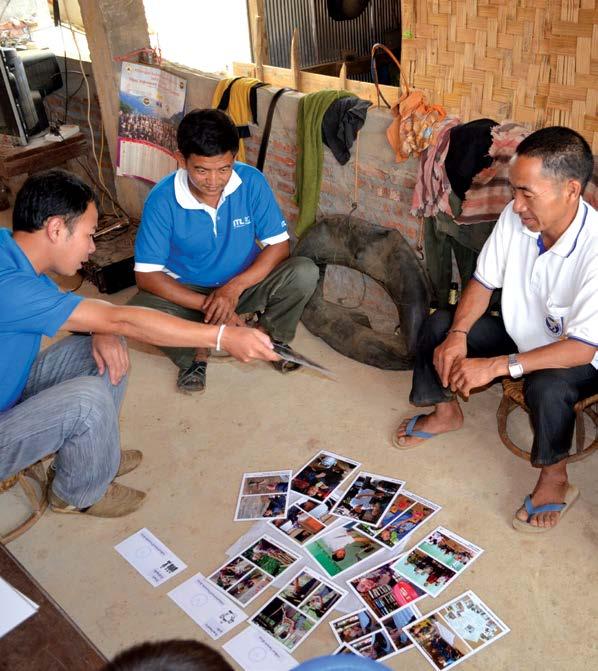
Plenary
Welcome
mins
-Ask the plenary for general comments on how they are feeling and what are the key things learnt from yesterday
• Welcome to Day 2 and recap of Day 1
• Provide an overview of Day 2
Purpose of today is:
To reflect on day 1 and understand the purpose and process of Day 2 activities.
• To run through Steps 5-9
• To increase confidence and capacity of facilitators to appropriately handle potentially challenging conversations relating to gender within a community meeting situation
• Clarify any outstanding questions or concerns about the tool
• Prepare for first community visit to put the GWMT into practice (start to think whether you would like to facilitate/notetake). 5 mins
Energiser –You can use any short energiser here
Example: Have You Ever… Form a circle of chairs (one for each person) and then take one away. One person stands in the middle and calls a question beginning with ‘Have you ever…’, for example
‘Have you ever eaten watermelon’. Everyone who has eaten watermelon then jumps up and moves to a place vacated by someone else who has moved. The last person who is left without a seat remains in the middle to call out something else beginning with ‘Have you ever…?’
GWMT Guide Flip charts from Day 1 Extra flip chart paper Copies of record sheets for note takers
Process
Demonstration and Role Play Steps 5, 6 and 7
Purpose
Step 5: Desired changes for women and men
Step 6: Sharing results Step 7: Closing Demonstration: trainer to explain the final steps in the community and some example questions and answers that may come up. Remind facilitators to refer to their guide books and follow instructions utilising guiding questions if they get stuck.
Role Plays
Purpose is for participants to understand and apply steps 5, 6 and 7.
• Facilitators and note takers can swap if they would like to have a chance to practice in Step 5
• Agree on who will be the lead facilitator for session 6 and 7 which is when the whole community is within one group again (all groups joined)
• Ensure notes and flip charts from yesterday are ready to use in discussions
• Ask everyone to review Step 5 and check in with new facilitators to ensure they are clear
• Tell everyone the same process will be followed for role plays as yesterday –we will role play steps 5, 6 and 7 and then debrief/question time.
Understand and apply Steps 5,6 and 7. To increase confidence and capacity of facilitators to appropriately handle potentially challenging conversations relating to gender within a community meeting situation.
Time
Materials 30 mins
The volunteer facilitators to role play Step 5
• Remain in the sex disaggregated groups from yesterdayone representing women and one representing men
• The volunteer facilitator to role play Steps 5 using GWMT guide
• Note taker to use record sheets to take notes as this will be used later for other steps of the GWMT
• Complete Step 5 and ensure volunteer facilitator for Steps 6 and 7 is clear on next steps.
Materials
Process
Purpose
Time
Morning tea –allocate morning tea where appropriate 1 hr
Play Steps 5, 6 and 7 (cont.)
Move straight into Steps 6 and 7
Volunteer facilitator to lead the role play of Step 6 and 7
• Invite men’s and women’s groups to join together to share results
• One volunteer facilitator to follow guidance from tool and facilitate a discussion between the groups, capturing any key agreements moving forward
• Ask the groups to bring up typical issues that they are aware of for what ever gender they are representing as if it was real
• Once complete –to thank everyone and close the meeting as per Step 7
Note: Watch for those with strong facilitation skills who could lead first community trials.
Trainers
Plenary discussion: In the plenary ask:
• What observations does the group make about each role play? What worked well? What did not work well? Think about the perspectives of both the facilitator, and a community member
• What strategies might be put in place to strengthen the facilitation process and the dialogue with the community
To share observations; learning; concerns, strategies and challenges of the GWMT.
15 mins
• Record strategies / any concerns and make changes to tool accordingly.
30 mins
(cont.):
Plenary discussion
• How did the facilitators and note takers go –what worked, what was challenging in the last few steps?
• What do you think would happen in reality and what challenges do you see arising –how to overcome them?
To share observations; learning; concerns, strategies and challenges of the GWMT.
• Now you have completed all steps in the tool that involve the community –what are your impressions? What are key learnings/challenges/strategies?
• How do you feel about implementing directly in communities now?
–Analysis and Step 9 documentation
Step 8
Step 8: Analysis of community’s progress towards gender equality (after community meeting)
Step 9: Documentation and improving practice. Ask the participants to:
• Read through Step 8 and collate information gathered during the role plays from the Note Takers using the final analysis tool
• Discuss importance of documentation and analysis process i.e. looking at “why” things have been assessed / ranked at certain levels as well as “what” key findings have emerged; What is the evidence?
Understand and apply Steps 8 and 9 of the GWMT. To understand the importance of documentation and analysis in the monitoring process.
• As a plenary, go through the record sheets for this step including explaining the rating scale and how to complete these forms
Process
Step 9
• Ask participants to turn to Step 9 in the Guidebook and talk through this step with relation to the WASH program’s M&E framework
Purpose
• Show the example of the framework documentation in the Guidebook (within Step 9 page 68). If the project’s integration of these indicators involves a different M&E framework, present that instead
• Highlight the importance of this step
• As a plenary, fill out 1-2 example rows of the M&E framework.
Check understanding with the group:
• Has the tool collected the required data?
Understand and apply Steps 8 and 9 of the GWMT. To understand the importance of documentation and analysis in the monitoring process.
• What are the gaps?
• What challenges remain?
• How can they be addressed?
CONGRATULATIONS –YOU HAVE NOW REVISED AND PRACTICED THE WHOLE TOOL –NOW LETS PREPARE FOR REAL LIFE!!
Time
Materials 1 hr
Materials
Process
Form Groups for Community Visit
Purpose
• Explain that over the next two days we will be putting the tool to practice in the community with the observation trial (tomorrow) and the full trial (the day after).
Tomorrows Observation Trial –in 2 communities
Roles to be allocated as follows: Participants and Trainers will be broken into 2 groups –1 group for each community. Trainers to be divided equally to support and observe participants. Each Group will consist of 15 participants who will play different roles. Gender balance preferable.
To identify roles and responsibilities of each participant in the application of GWMT in the community.
40 mins
Roles:
• 1 Lead Facilitator who will also lead subgroup
• 5 Co-Facilitators
• 6 note takers (to be paired with a facilitator)
• 3 observers that can provide feedback Group Work
• Move into the two allocated groups now and ask 2 Trainers to assist their groups to plan the process:
• Clarify roles of each participant
• Logistics (transport, time, location, lunch stop, materials required etc)
• Hand out photo copies of record sheets to note takers and clarify questions
• Any questions about the observation trial tomorrow
• Any questions or clarifications about the tool
Form Groups for Community Visit (cont.)
Plenary:
• Recommend everyone to read the tool again overnight–particularly facilitators who should be prepared and try not to read too much from their notes while in the community
• Remind everyone that after the pre-trial in the community tomorrow, they will need to come back to this workshop venue (or other agreed location) for debriefing and planning for following day.
Afternoon tea
Any final feedback or points of clarification from the group
To ensure participants are clear on the tool and roles within the trial.
Ensure key logistics and administration information is clear to everyone for tomorrow’s pre-trial Close
Thank everyone for their time! [The trainers to liaise with each other for preparing for tomorrow’s community visit and debriefing as needed]
To ensure the trial is organised and well planned.
20 mins
20 mins
15 mins

Flip charts
Marker pens
Masking tape
Process
GWMT in practice
Purpose
Time
Materials AM
To trial the tool in communities for the first time and allow participants to experience first hand the steps of the GWMT in their entirety.
GWMT is undertaken in 2 communities by the 2 separate groups running in parallel PM
Lunch may be on return or on the run depending on where the communities are based and travel time. PM (1 hour)
Review and debrief of practical application
Step 8: Analysis of community’s progress towards gender equality (after community meeting) (30 minutes)
Venue -in a quiet area if available or back in the training room depending on context
In your two groups, refer to Step 8 of the GWMT guidebook and follow the instructions in the GWMT guidebook for step 8 ‘Analysis of gender relations in the community’.
To practice documentation of real monitoring data. To analyse and learn from community findings.
3 –Practice and Observation Trial
Process
Review and debrief of practical application (cont.)
Purpose
Time
Materials PM (1 hour)
Example: Trainers to provide specific feedback to the group –this can be as a group, and as individuals…. “Tuan –I liked the way you encouraged the quieter women to speak” or “Lyn –the way you summarised the key points with that the community worked really well”, or “Lee –next time try clarifying points made by the community if they are not clear” or “Paul –the way you initially described the instructions was not clear and the group was confused….what do you think you could do next time to improve?” Give specific feedback of what worked well and what didn’t….
Feedback to be provided to each groups as well by trainers.
To share and learn from experiences during the trial and make adjustments for the full trial the following day.
Plenary: 2 groups report back findings and analysis from Step 8. Reinforce the major strengths of the tool/ monitoring process/facilitation that have come up Then discuss the following:
• What could be done to address the major problem/concerns?
• What strengths can we build upon?
• Coordinators to sum up the successes and learnings from the trial.
Note: Please ensure a trainer is taking notes here. It is important to capture and record key outputs and learnings from these discussions so that they can be integrated into changes required for future trials and trainings. CONGRATULATIONS EVERYONE –FIRST TRIAL IN A COMMUNITY IS COMPLETE!!!
Prepare for the full trial tomorrow –plenary
Full trial –in 3 communities
Participants and Trainers will be broken into 3 groups –1 group for each community. At least one trainer to be allocated to each group. Each group will consist of 10 participants who wil play different roles. Gender balance preferable.
Participants to feel prepared and understand their roles for the full trial.
Roles
• 1 Lead Facilitator who will also lead subgroup
PM (20 minutes)
• 5 Co-Facilitators
• 4 note takers (paired with facilitator)
• Due to nu mbers, trainer can play role of note taker and a facilitator will need to take notes as well as facilitate.
Group Work
• Move into the three allocated groups now and ask the 3 Trainers to assist their groups to plan the process the same as yesterday:
• Clarify roles of each participant
• Logistics (transport, time, location, lunch stop, materials required etc)
• Hand out photo copies of record sheets to note takers and clarify questions
• Any questions about the observation trial tomorrow
• Any questions or clarifications about the tool.
Plenary:
• R ecommend everyone to read the tool again overnight–particularly facilitators who should be prepared and try not to read too much from their notes while in the community
• Remind everyone that after the full trial in the community tomorrow, each of the 3 groups will need to undertake Step 8. This can be done back in training roomor another place if distance from commu nity is too far.

GWMT in practice
For all participants to play a role to implement the GWMT in the comminutes and begin to feel more confident.
AM
GWMT is undertaken in 3 communities by the 3 separate groups running in parallel. PM
Review and debrief of practical application
Step 8 (30 minutes)
Lunch after trial PM (30 min)
Each of the 3 groups to independently undertake Step 8 of the GWMT guidebook (note there will be more opportunity for debrief tomorrow).
Venue -in a quiet area if available or back in the training room depending on context.
Documentation of monitoring data. Analysis of individual community findings.
Note: Please ensure a trainer is taking notes here. It is important to capture and record key outputs and learnings from these discussions so that they can be integrated into changes required for future trials and trainings.
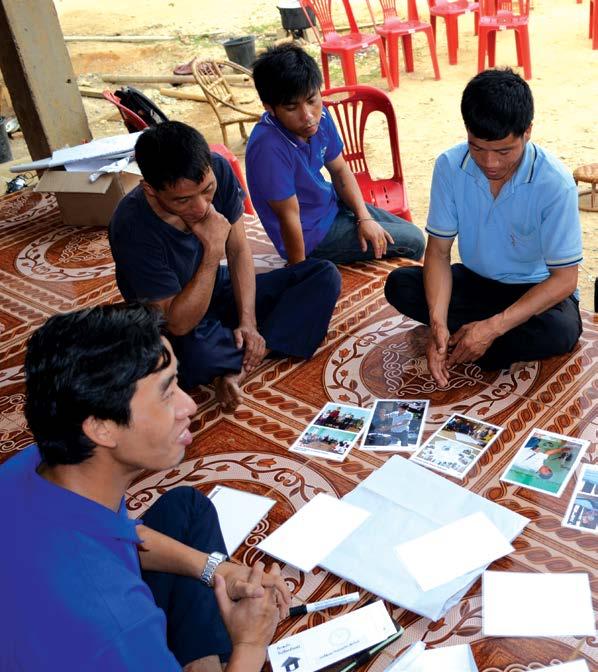
Welcome
• Congratulate everyone on the day before and ask the group for general feedback of how the day went.
• Explain todays purpose is to:
• collate and analyse the data
To introduce the purpose of the day.
• obtain commitment to undertake the GWMT going forward
• make recommendations to program practice due to findings
• learn from each others collective field experiences
• discuss the use of the tool into the future
Materials
Flip chart with the matrix of the 4 indicators drawn up (see Step 8 Record Sheet in GWMT) Marker pens (x5 colours) Tape
Participants to bring their field results back Flip chart paper and marker pens
Process
Plenary
Why is analysis of the data so important?
Ensure these points are included (if they are not mentioned by the group):
• To understand, document and assess communities’ gender relations against the 4 indicators and note changes over time
• To consolidate results in the one place of the GWMT data collected in each community
• To provide documentation and records for the project MEL and reporting purposes
• To compare results across monitoring visits in the same community
• Based on this monitoring process, provide feedback to the WASH project if project activities and strategies are contributing to improving better outcomes for women and men and if not to develop strategies to address this
Purpose
Time
Reinforcing the importance of collating monitoring information.
30 mins
• To compare results between communities
• To provide feedback to the community on progress.
Step 8 (refer to Step 8 of the GWMT guidebook)
Draw up on large flip chart paper the four indicators tables as per Step 8 record sheet. Within the plenary, one group at a time report back as they enter their data (and evidence) onto these indicators tables. Each group to write in a different colour. As a plenary, follow the instructions in the GWMT guidebook for Step 8 ‘ Analysis of gender relations in the community’
Collating monitoring information (against the 4 indicators). Mapping of the ‘collective story’ and analysing the data.
45 mins
15 mins
Morning tea [working morning tea if extra time is needed…] Day 5 –Post Trial Workshop (cont.)
Small group workSplit into the 3 groups from the 3 communities. The 3 lead facilitators to facilitate a discussion for each of their groups following the instructions in the GWMT guidebook for Step 8 ‘Analysis of the GWMT process’. Plenary discussion -
• Reinforce the major strengths of the tool/monitoring process/facilitation that has come up. What strengths can we build upon?
Purpose
Time
• For any major problems/concerns ask the group what could be done to address this?
• Sum up the successes and learnings from the trial
Sharing experiences and learnings from the week –Does the tool work? To obtain feedback about the tool’s content and processes.
1 hr 15 mins
• Trainers and others to provide each other specific feedback to the group –this can be as a group, and as individuals.
Note: Please ensure a trainer is taking notes here. It is important to capture and record key outputs and learnings from these discussions so that they can be integrated into changes required for future trials and trainings.
Process
Purpose Materials
chart Marker pens
Flip
Next steps
Discuss next steps.
30 mins
Plenary discussion Lead a discussion on the following and write up on flip chart. Where there are actions, put timelines next to the actions. Devise action plan to ensure the next GWMT visit is planned (usually between 6-12 months). Suggested questions for discussion:
• What plans can you realistically put in place now for ‘next steps’ so that the GWMT can be incorporated into your WASH project?
• How this tool will sit within the MEL framework of the WASH program and what this would mean for participants
• How will you share the results and who with?
• What adaptations need to be made?
• Who will lead and what resources do we need?
Process
Evaluation: (15 mins)
Put up four flip chart papers around the room titled:
Purpose
Time
Materials 30 mins
Evaluation and close workshop.
1. What I learnt most in the training:
2. What I liked most about the training:
3. Areas for improvement for the training:
4. Feedback for the trainer (what the trainer did well and what they should do differently next time): Tip: Trainer to leave the room so that people have the space and confidence to write their thoughts freely. Close (15 minutes)
• Ask everyone to form a circle
• Thank everyone for their time and wish luck in their on going WASH program
• Hold up a small ball and ask people to express their feelings in a couple of word about the week’s training
• Throw the ball to a participant –they will express how they feel and will then throw the ball on to another until everyone has had a chance to say something
• Close the training….and relax –well done!!
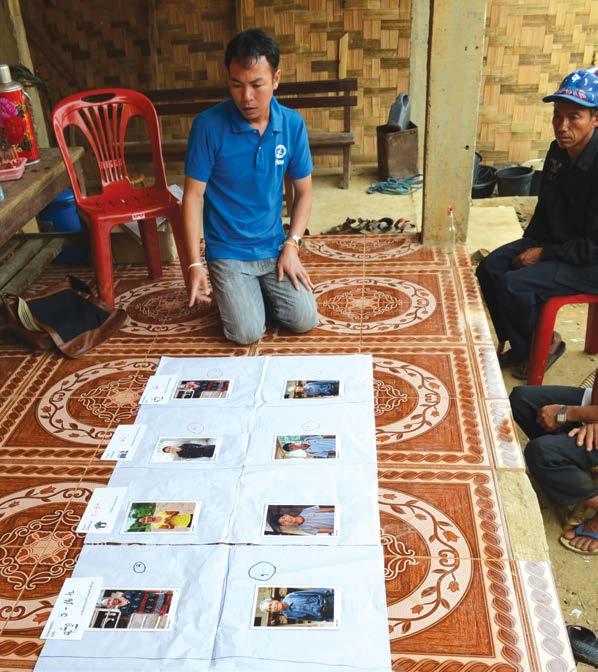
This suggested GWMT preparatory training is broken into the following 4 components:
1. Introduction Pre-Trial: Participants will be reminded about key gender and WASH concepts, introduced to the GWMT and start practicing using the GWMT within the training room
2. Practice and Observation Trial: A chance to see and experience the GWMT in action in a community
3. Full Trial: All participants experience facilitating the process in a community

4. Post-Trial workshop: Collate and analyse the results; debrief including assessing the experience, tool and processes; and developing next steps.
Table 1.1 provides an overview the how the 4 components could be scheduled over a 5-day training period. This may vary according to your context and needs. See next page:
Table 1.1: Sample Five-day GWMT preparatory training overview
Day 5
Post-Trial Workshop (training room)
Review the trial. Analyse the results, refine the tool and facilitation processes, next steps
Debrief
30 Participants in Training Room to debrief and analyse experiences and results from trial
Day 4
Full Trial (community)
Trial in 3 communities with everyone playing a role
Participants and Trainers will be broken into 3 groups –1 group for each community. At least one trainer to be allocated to each group. Each group will consist of 10 participants who wil play different roles. Gender balance preferable.
Roles:
1 Lead Facilitator who will also lead subgroup
5 Co-Facilitators
4 note takers (paired with facilitator)
Due to numbers, trainer can play role of note taker and a facilitator will need to take notes as well as facilitate.
Day 3
Practice and Observation Trial (community)
Day 2
Trial in 2 communities with most confident facilitators/note takers leading and others observing
Review and process the learning from trial
Participants and Trainers will be broken into 2 groups –1 group for each community. Trainers to be divided equally to support and observe participants. Each Group will consist of 15 participants who will play different roles. Gender balance preferable.
Roles: 1 Lead Facilitator who will also lead subgroup
5 Co-Facilitators 6 note takers (to be paired with a facilitator)
3 observers that can provide feedback.
Day 1
Time
Introduction Pre-Trial (training room)
Introduction and practice of steps 5-9
Gender concepts –WASH specific
AM
Preparation for trial in communities
Overview of Tool. Introduction and practice of steps 14
PM
30 Participants in Training Room to learn and practice in safe learning environment
Break down of Roles
Instructions:
Preparation: Before training, download, print cards and be clear on instructions. After the activity, you may also like to print this as a hand out.
• Stick the Concept Titles to the wall with all the definitions mixed up on the floor
• Instruct the participants to look at all the concepts and definitions, and as a group decide which concept matches the definition
• Ask them to stick the correct definition to match the concept on the wall
• Go through each concept reading the definitions out loud. Ask participants: Have they all been correctly matched? Do any need to be swapped?
• Facilitate a discussion around the key concepts and why they are important to understand in WASH.
Gender:
• The socially-learned roles and responsibilities that are assigned to females and males in a given culture, time and place
• Learned behaviour that changes across time, place and culture
• How women and men are perceived, how they are expected to behave or how they feel they are expected to behave.
Sex:
• Biological differences between men and women.
Gender Equality:
• Refers to equal rights, responsibilities and opportunities for women and men, girls and boys. Equality does not mean that women and men will be the same but that women’s and men’s rights, responsibilities and opportunities will not depend on whether they are born male and female. Gender equality implies that the interests, needs and priorities of both women and men are taken into consideration, recognising the diversity among different groups of women and men. Equality between women and men is a human right, and a precondition for, and an indicator of, sustainable people-centred development
• The condition of fairness in relations between females and males, leading to a situation in which each has equal status, levels of responsibility and access to power and resources.
Gender Analysis:
• The process of assessing the implications for women and men of any planned action, including legislation, policies or programs, in all areas and at all levels
• A systematic way of looking at the different impacts of development projects on males and females. It requires separating data by sex and understanding how labour is divided and valued. Gender analysis must be done at all stages of the development process and always ask how a particular activity, decision or plan will affect males differently from females.
Gender Awareness:
• Sensitivity to the perceived differences in roles and relations of women and men and how this results in differences in power relations, status, opportunities and needs in an organisation or community, workplace or classroom.
Practical Gender Needs:
• Needs that have been identified by women in relation to their current sociallydefined roles. Meeting these needs might make women’s life easier but it doesn’t change their status in society (e.g. a water supply which reduces women’s physical labour or time burden)
• A result of the unequal gender division or resources, responsibilities and power.
Strategic Gender Needs:
• Vary by context and are identified by women as a result of their lower social status
• Tend to challenge gender divisions of labour, power and control, as well as traditionally-defined norms and roles (e.g. legal rights, domestic violence, equal wages, and women’s control over their bodies).
Gender Division of Labour:
• The socially-determined ideas and practices that define what roles and activities are considered appropriate for women and men. Most societies allocate different roles, responsibilities, and activities to women and men, but the nature of the work that is allocated to men and women varies greatly between and within countries and cultures.
Sex-Disaggregated Data:
• The differentiation by sex of statistical and other data. It is a basic requirement for good practice in development programming, because without it, it is difficult to determine the gender impacts of development activities. Gender analysis requires data to be separated by sex, to allow different impacts on men and women to be measured.
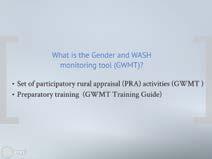
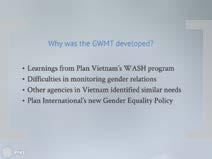

GWMT Overview Presentation Slides
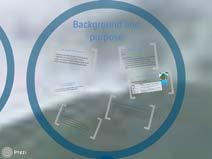


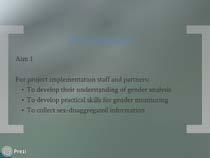
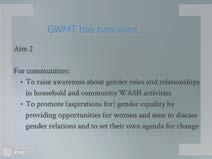
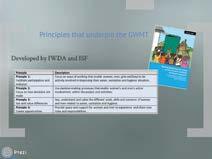
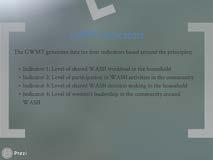
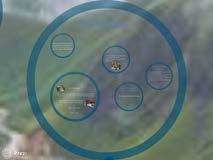
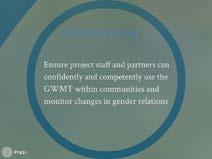
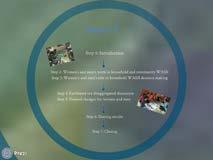
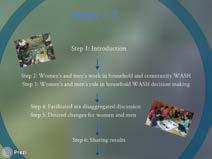
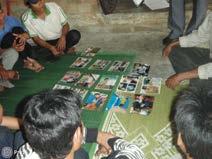
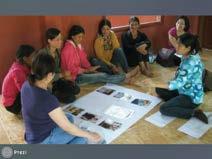
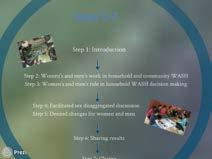
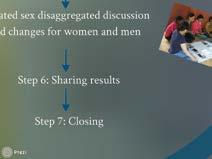
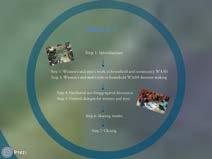
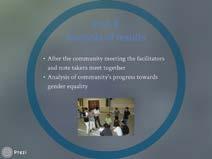

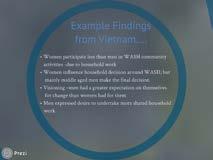




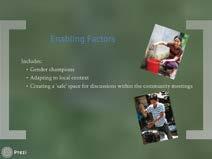

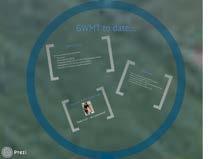
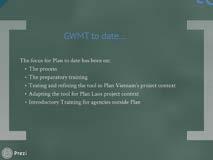


For further information and to provide feedback, please contact Plan International Australia WASH team at WASH@plan.org.au All materials can be downloaded from our website: www.plan.org.au/Learn/Gender-and-WASH-Tool